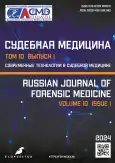通过对某些类别的人体内植入芯片确保对个人数据的保护:科学综述
- 作者: Amirov A.M.1, Begaliyev Y.N.1, Baimakhanov A.A.1, Bakhteev D.V.2
-
隶属关系:
- Academy of Law Enforcement Agencies Under the General Prosecutors Office of the Republic of Kazakhstan
- Ural State Law University named after V.F. Yakovlev
- 期: 卷 10, 编号 1 (2024)
- 页面: 56-67
- 栏目: 科学评论
- URL: https://journals.rcsi.science/2411-8729/article/view/254427
- DOI: https://doi.org/10.17816/fm16096
- ID: 254427
如何引用文章
全文:
详细
本文介绍对某些类别的人体内植入芯片问题的各个方面。在工作中,作者试图确定这一机制的有效性,包括在保护个人数据、作为鉴定工具以及用于医疗目的方面的有效性。
该文章考虑哈萨克斯坦和外国有关芯片植入问题的立法准则、该方法在鉴定中的优点,以及有关该主题的科学出版物。文章重点介绍科学家们在计算机技术鉴定问题上的研究成果,以及在医学和法医学鉴定中成功应用最新技术的情况。需要指出的是,目前还没有关于公民体内植入芯片的可能性以及该技术在包括法医学鉴定在内的各个领域的应用的全面研究。
作者对某些类别人员的芯片植入问题进行了SWOT分析,包括个人数据保护问题。此外,考虑到了采用该技术的优势和劣势、能力和威胁。
在对立法进行分析和研究的基础上,作者提出了对执法人员、公务员、可访问国家个人资料数据库的组织雇员、作为非国家数据库所有者或经营者的组织雇员体内植入芯片的建议。拟议的机制有许多优点,并提供一个机会来提高安全性和减少未经授权访问信息的事实,最大限度地减少与个人数据和有限访问数据有关的可能的非法行为。
作者简介
Almas M. Amirov
Academy of Law Enforcement Agencies Under the General Prosecutors Office of the Republic of Kazakhstan
编辑信件的主要联系方式.
Email: han1k1986@mail.ru
ORCID iD: 0000-0002-9960-9339
SPIN 代码: 2346-7009
哈萨克斯坦, Koshy
Yernar N. Begaliyev
Academy of Law Enforcement Agencies Under the General Prosecutors Office of the Republic of Kazakhstan
Email: ernar-begaliev@mail.ru
ORCID iD: 0000-0001-6659-8576
SPIN 代码: 1929-3392
Dr. Sci. (Legal), Professor
哈萨克斯坦, KoshyArtur A. Baimakhanov
Academy of Law Enforcement Agencies Under the General Prosecutors Office of the Republic of Kazakhstan
Email: drartur@list.ru
ORCID iD: 0000-0002-8673-8000
SPIN 代码: 9160-2394
Dr. Sci. (Legal)
哈萨克斯坦, KoshyDmitry V. Bakhteev
Ural State Law University named after V.F. Yakovlev
Email: dmitry.bakhteev@gmail.com
ORCID iD: 0000-0002-0869-601X
SPIN 代码: 8301-7165
Dr. Sci. (Legal), Associate Professor
俄罗斯联邦, Ekaterinburg参考
- Kolistratov MV, Vereskun AK. Modern ideas about the methods of application of implantable microelectronic devices. E-Scio. 2023;(7):189-198. (In Russ). EDN: KSEDLU
- Alikperov HD. Global remote crime control: acceptability, opportunities, costs. Criminology: yesterday, today, tomorrow. 2016;(3):26-33. (In Russ). EDN: WWRTDB
- Tyurin IV. Remote control over crime. Is it possible? Criminology: yesterday, today, tomorrow. 2017;(1):44-46. (In Russ). EDN: ZBFTSL
- Borisov DN, Sivashchenko PP, Kushnirchuk II, Rodionov EO. Improving approaches to organizing drug care based on RFID technology. Pharmacoeconomics: theory and practice. 2019;7(1):23. EDN: CIQNZR doi: 10.30809/phe.1.2019.3
- Gainelzyanova VR. Possibilities of forensic computer-technical examination in the investigation of crimes in the field of computer information. Bulletin of Ufa law institute. 2021;(1):144-149. EDN: LMFXEE
- Lantukh EV, Ishigeev VS, Gribunov OP. The use of special knowledge in the investigation of computer crimes. Russian journal of criminology. 2020;14(6):882-890. EDN: VHTUKP doi: 10.17150/2500-4255.2020.14(6).882-890
- Sysenko AR, Smirnova IS, Timoshenko SE. Problems of appointment and production of forensic computer-technical expertise. Siberian law review. 2020;17(4):523-533. EDN: GOOZQR doi: 10.19073/2658-7602-2020-17-4-523-533
- Koshelev DA Timchenko TV. Possibility of using cloud and fog technologies for monitoring the health of military personnel. In: Radiolocation, Navigation, Communication: Proceedings of the XXV International Scientific and Technical Conference dedicated to the 160th anniversary of A.S. Popov. 2019. Vol. 1. Р. 114-123. (In Russ). EDN: WAVBLH
- Kupriyanova IA, Zhavoronkova AA. Artificial intelligence in the health care system: analysis, planning and programme solutions. In: Formation of mechanisms of sustainable economic development: Proceedings of the III All-Russian (with international participation) scientific-practical conference. Simferopol; 2023. Р. 277-282. (In Russ). EDN: XANOZC
- Nedugov GV. New computer technologies to determine postmortem interval by the Henssge method. Russ J Forensic Med. 2021;7(3):152-158. EDN: NLBPEN doi: 10.17816/fm406
- Leonov SV, Shakiryanova YP, Pinchuk PV. Development prospects of 3D modelling in forensic medicine: Bim-technology and 4D modelling. Russ J Forensic Med. 2020;6(1):4-13. EDN: TDKORK doi: 10.19048/2411-8729-2020-6-1-4-13
- Klevno VV, Chumakova YV, Pavlik DP, Dubrova SE. Potential of the virtual autopsy in case of firearm injury. Russ J Forensic Med. 2019;5(3):33-38. EDN: PMIIDQ doi: 10.19048/2411-8729-2019-5-3-33-38
- Orakbayev AB, Kurmangali ZhK, Begaliyev YeN, et al. ON The issue of using the results of a virtual autopsy in criminal investigation: A review. Russ J Forensic Med. 2023;9(2):183-192. EDN: OEERGD doi: 10.17816/fm774
- Bakhteev DV. Artifiial intelligence in forensic science: Current state and application potential. Russian Law: Education, practice, researches. 2018;(2):43-49. EDN: XSESHB
- Voyevodkin DV, Rustemova GR, Begaliyev YN, et al. Identifying fake conclusions of forensic medical examinations using an artificial intelligence technology based on the experience in the Republic of Kazakhstan: A review. Russ J Forensic Med. 2023;9(3):287-298. EDN: EFNJIE doi: 10.17816/fm8270
- Shchastny AT, Mikhnevich EV. Achievements and problems of transplantology at the present stage. Vestnik Vitebskogo Gosudarstvennogo Meditsinskogo Universiteta. 2018;17(5):7-16. EDN: YLHIBF doi: 10.22263/2312-4156.2018.5.7













